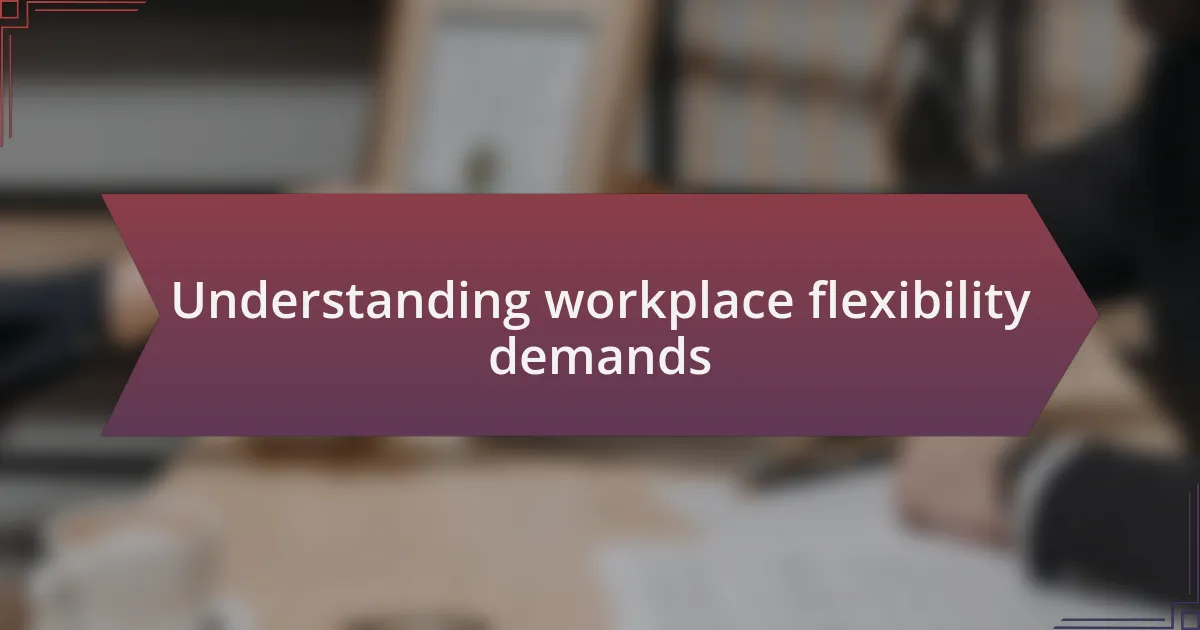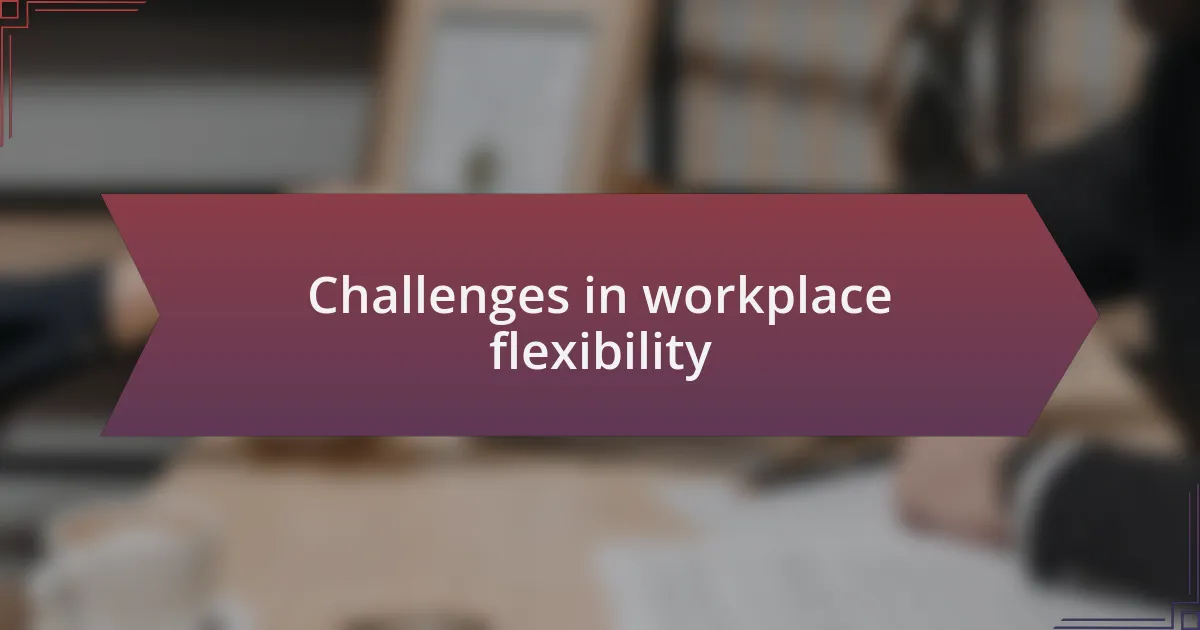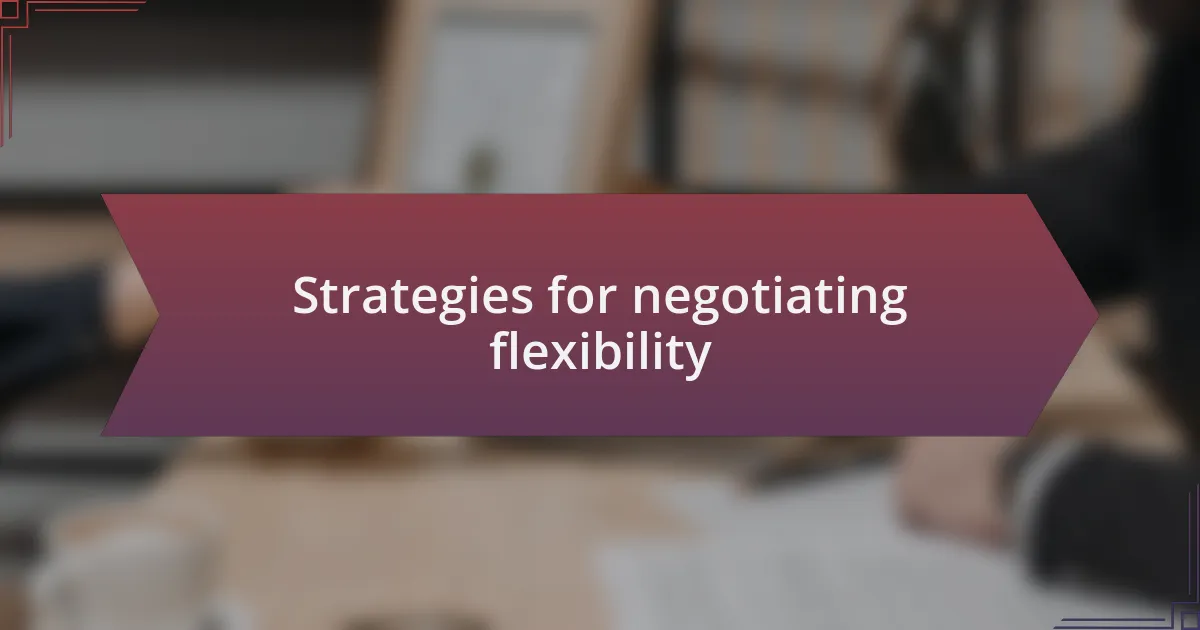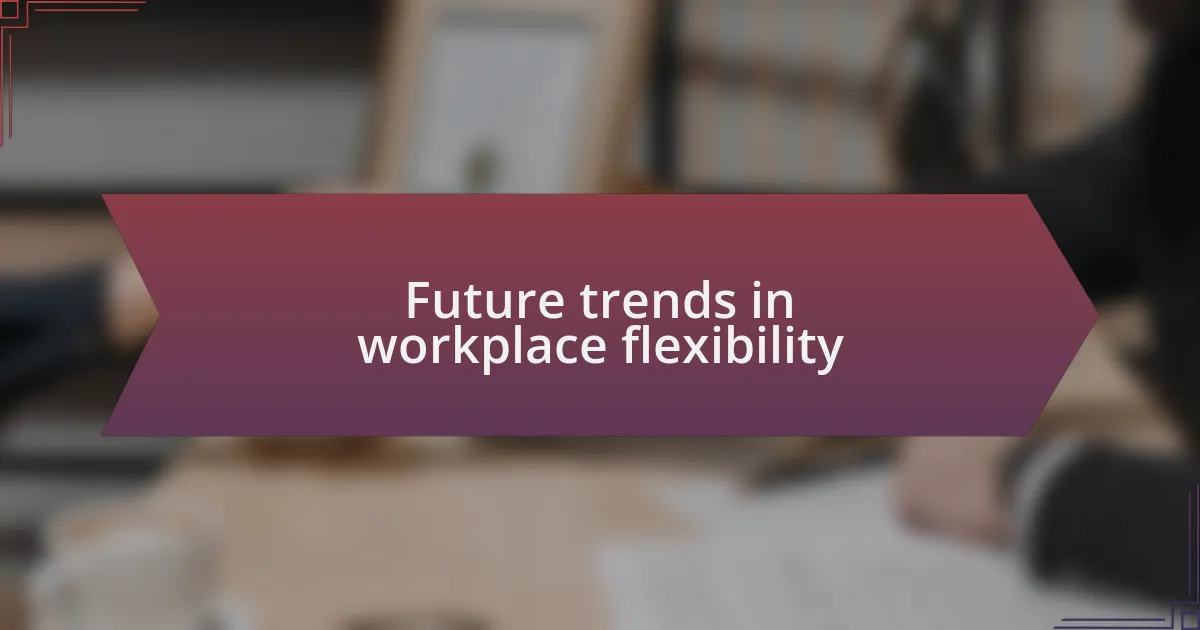Key takeaways:
- Workplace flexibility enhances productivity and employee commitment, emphasizing trust between employers and employees.
- Clear employment laws are essential for protecting rights, preventing discrimination, and fostering a positive work environment.
- Effective negotiation for flexibility involves understanding personal needs and including proposed solutions while engaging in open discussions with employers.
- The future of flexibility trends towards hybrid models and an increased focus on employee well-being, supported by technology innovations.

Understanding workplace flexibility demands
Workplace flexibility demands have evolved significantly over the years. I remember when I first encountered the concept; it felt revolutionary. The ability to choose when and where to work allowed me to manage my time better, balancing professional responsibilities with personal commitments. Isn’t it incredible how much more productive I felt simply by having that choice?
As I delved deeper into the realities of flexible work arrangements, I started to appreciate the emotional aspect. There was a time when a family obligation clashed with my work schedule. Having the option to shift my hours not only eased my stress but also strengthened my commitment to my job. This experience made me realize that flexibility isn’t just about convenience; it’s about trust and understanding between employers and employees.
Reflecting on these demands, it’s clear that different people have different needs. Some thrive in the traditional 9-to-5 structure, while others seek the freedom to work late at night or early in the morning. How do we balance these differences in the workplace? Finding common ground is crucial, and addressing flexibility demands is more than just a trend; it’s a fundamental shift that speaks to the heart of employee well-being.

Importance of employment law
Employment law plays a crucial role in safeguarding the rights of both employers and employees. For example, I once witnessed a situation where an employee was denied a reasonable request for flexible hours due to a lack of clarity in company policies. This not only created tension but also illustrated the importance of clearly defined laws that protect the workforce while allowing employers the structure they need to operate effectively.
I’ve seen firsthand how robust employment laws can foster a positive work environment. When employees are aware of their rights regarding flexible work options, they feel more empowered to advocate for themselves. It prompts a culture of openness and trust, which, in my experience, can significantly enhance job satisfaction and overall productivity.
Moreover, effective employment laws help prevent workplace discrimination and ensure that everyone has access to flexible work arrangements. I remember a colleague who thrived when given the chance to work from home. If employment laws enforce fair practices, it allows companies to maximize their talent pool. Isn’t it essential for every team member to have equal access to opportunities that suit their unique circumstances?

Legal frameworks for flexibility
Legal frameworks for flexibility can often feel like a double-edged sword. I recall a project where our team was navigating new flexible work arrangements under existing laws. It became more challenging than anticipated, as the varying guidelines highlighted the nuances in state and federal regulations. Those complexities made it clear that while the intent behind these laws is noble, the specifics can sometimes leave employers and employees in limbo.
A fundamental aspect of legal frameworks for workplace flexibility is the balance between rights and responsibilities. When I was advocating for my own flexible work schedule, I encountered resistance from management who cited vague company policies. It struck me then how critical it is for legislation to explicitly outline both the employees’ right to request flexibility and the parameters within which employers can respond. This clarity can prevent misunderstandings and create a more collaborative atmosphere.
Sometimes, I wonder if employees fully realize the protections offered by employment laws regarding flexibility. I remember having conversations with colleagues who believed they had to choose between their career aspirations and personal obligations. It’s essential for workplaces to not only communicate these rights but also to foster a culture where flexibility is seen as a benefit rather than a burden. Strong legal frameworks can serve as a foundation for this dynamic shift, but they need to be actively applied and understood by all involved.

Challenges in workplace flexibility
Navigating workplace flexibility can sometimes feel like walking a tightrope. I remember a time when I sought a flexible schedule to balance family commitments, only to find that my enthusiasm clashed with coworkers who believed flexibility meant additional burdens for them. That experience made me acutely aware that not everyone views flexibility the same way—it can create friction if not approached thoughtfully.
One substantial challenge I faced was the lack of managerial support. During a particularly busy quarter, I had requested a reduction in my hours. Instead of facilitating that conversation, my manager seemed overwhelmed and pushed back, suggesting that it was an all-or-nothing situation. This left me feeling frustrated and underappreciated, underlining the importance of leadership being receptive to flexibility requests and understanding the broader impact on employee morale.
Then there’s the issue of technology. I vividly recall a remote work setup where connectivity issues and software glitches disrupted our workflow. It made me question: how equipped are we really to handle flexibility? While technology can be a powerful enabler of flexible work, not everyone has the same access or proficiency, which can perpetuate feelings of inequality among team members. A cohesive strategy is vital to ensure that flexibility fosters inclusivity rather than exclusion.

My personal experience with flexibility
There was a time when I embraced a more flexible work arrangement, which allowed me to pick my hours and work from home when necessary. On the surface, it sounded perfect—more time for my family and the ability to focus without office distractions. Yet, I quickly realized that my productivity fluctuated, and I often found myself missing the camaraderie and instant feedback that came from working alongside my colleagues.
On another occasion, I faced a rather revealing moment during a team meeting. With everyone participating virtually, I felt empowered to share how my flexible schedule was helping me thrive, but I was met with indifferent responses. It struck me: how can we cultivate a culture of openness about flexibility when our experiences don’t seem to resonate with others? That day reinforced my belief that sharing personal experiences is crucial for promoting understanding among team members.
Reflecting on these moments, I often wonder how we can bridge the gaps in our perceptions of flexibility. It’s not just about what works for one person; it’s about finding common ground to create an inclusive environment. I believe it starts with fostering open communication, where sharing our individual stories can lead to discovering solutions that benefit both employees and the organization as a whole.

Strategies for negotiating flexibility
Effective negotiation for workplace flexibility often begins with a clear understanding of your own needs and objectives. I remember when I first approached my manager about adjusting my hours; I came prepared with a list of how this change could benefit both of us. I outlined my productivity peaks and how aligning my schedule with them would not only enhance my output but also contribute positively to the team’s goals. Have you ever considered how your specific circumstances—like family commitments or personal routines—could align with company interests?
Engaging in a candid discussion with your employer is critical. I found that sharing my challenges helped my manager see flexibility not merely as a perk, but as a key to unlocking my full potential. When we exchanged views, it became evident that a tailored approach would benefit the team’s dynamics. Don’t you think that opening up about your situation could lead to a more productive conversation?
Another strategy is to proactively offer solutions. For instance, when I proposed a staggered schedule, I also suggested how I could remain accessible during overlapping hours for collaboration. This proactive mindset not only shows your commitment but also helps create a win-win scenario. Have you thought about what alternatives you could suggest to make flexibility appealing to your employer? This kind of thoughtfulness can foster goodwill and demonstrate your dedication to both your role and the company.

Future trends in workplace flexibility
As companies continue to embrace workplace flexibility, I see a significant trend toward hybrid models becoming the norm rather than the exception. A friend of mine, who switched to a hybrid arrangement, discovered that being in the office just two days a week significantly improved her work-life balance while also boosting her team’s engagement. Have you noticed how the blend of in-person and remote work can create a more dynamic atmosphere?
Looking ahead, I believe technology will play a pivotal role in shaping flexible work environments. For instance, my experience with project management tools has shown just how much they can facilitate communication in a remote setup. As we adopt more advanced tech solutions, like virtual reality meetings or AI-driven scheduling tools, flexibility will not only become more manageable, but it will also foster a sense of connectivity among dispersed teams. Isn’t it exciting to think about how these innovations might change our daily work experiences?
Moreover, I predict that employee well-being will take center stage in discussions about workplace flexibility. In my own journey, companies that truly prioritized mental health saw profound shifts in employee satisfaction and retention. As more organizations recognize that flexibility isn’t merely a response to demands but a crucial aspect of a healthy work culture, I believe we will see more tailored options that address individual needs. Can you imagine how this holistic approach could transform workplace dynamics?